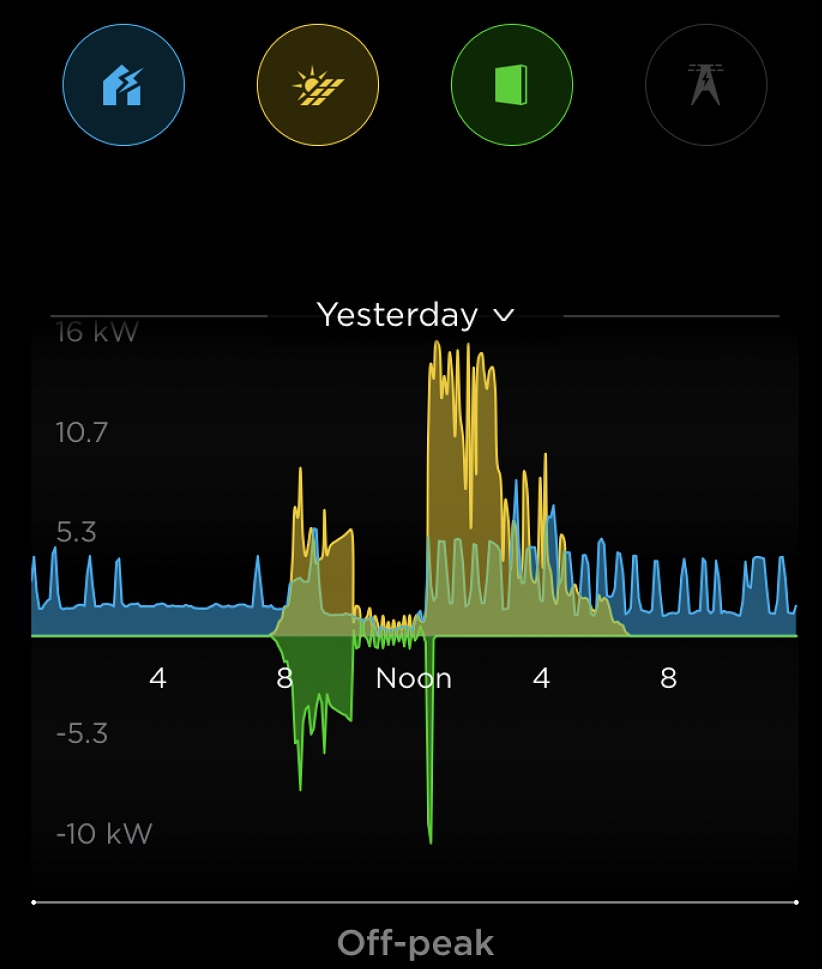RIKLBLOG
|
| Tomorrow |
| 22 April 2019 |
| Yesterday |
| Index |
| Eventide |
| SETI League |
| PriUPS Project |
| Bonus! |
| Contact |


But First, I Have a "The" Problem
Today's Now Playing is "Suicidal Flowers" by [The] Crystal Chandelier. As I listen to obscure songs from the psychedelic era of the '60s, I'm finding that that the band names are transcribed inconsistently, sometimes with a "The," sometimes not. It may not even be carelessness, since the bands themselves may have dropped the definite article in their sequence of albums. Perhaps Windows could be trained to ignore "The" when sorting files. I'll email Microsoft real soon now.
A Year of Energy Shifting
I love my solar system.
I love my Tesla batteries.
I'm not so keen on Tesla, though. The battery hardware does exactly what it is supposed to: It charges when it can, and discharges when needed. Good batteries!
But the batteries take their instructions not from me, to whose house they're attached and whose wallet has had a cashectomy, but rather from the Tesla App, which was written by clueless and non-responsive people who are unwilling or unable* to make one simple, sensible modification that would have saved me many hours over the past year. Grrrr, application writers!
I wrote a brace of blogitems last March detailing the installation and technical details of the Powerwalls. It would be nice if you went back and read all of it, but I can hardly ask you to do that since I am reluctant to do it myself. Too many details there, not enough overview. Here's the overview:
The batteries, at least for my grid-connected house, should serve two functions only:
- They should provide backup power when the grid goes down.
- They should charge when electricity is cheap, and discharge when it is expensive.
They're doing a splendid job of backup. I had 10 "Events" during the past year. Nine of them were between five and six minutes each and the batteries provided no significant power. Those Events were no doubt triggered by glitches or surges. But one Event lasted for three hours and 13 minutes due to a genuine grid failure, and the Powerwall system kept all my critical infrastructure** running while the grid was down.
A Real Power Failure!
The grid was down from about ten AM to one PM. During that time, the A/C and heating, which is a big load, was shut down. But everything else was running on solar/battery power. Note that the solar power decreased during the failure - it had "nowhere to go" since the grid was disconnected and the house required minimal power at the time. Shortly after the failure was resolved, the negative green spike shows that the Powerwall was re-charging from solar power to compensate for its usage during the failure.

Incredible Coincidence!
The next paragraph was to have been a whine about how the Tesla App fails to comprehend its mission. That paragraph in just a minute...
This interruption is due to a telephone call I just received from Tesla! Yes, while I was scribbling this blog they called to notify me that there was a problem with my system and wanted me to check the toggle switches because the batteries weren't doing anything! I had a long chat with the gentleman who answered my return call and told him pretty much what I'm about to tell you after the end of this paragraph, which is nearly finished. I thanked him for monitoring my system, and reminded him that it's Easter Sunday as I write this, and the batteries are properly doing nothing since there is no peak usage either on Sunday or on Holidays. Today being one of each, I asserted everything is OK and on further checking he agreed.
Incredible Coincidence Over, I Continue
During our conversation, I belabored the points I make now. The first is that the App tries to do silly and unnecessary things. For example, on Friday night, since there is no peak period on Saturday, the batteries continue to discharge after Friday's peak period. Why? Well, they "believe" that they will have plenty of solar power during the weekend to re-charge. True! They will. But there is a 10% energy loss in the charge and discharge cycle, so the grid will have to supply (at my cost) the additional 10%, the batteries will have slightly more wear, and, potentially the most serious, if there is a power failure, the batteries will be at a lower state of charge when called upon. All easily fixed by removing the special programming that someone foolishly provided for Friday evening! Apparently I am neither the only nor the first person to comment on this. I've been added to a "list."
Another complaint, which would be mostly unnecessary if the App weren't so recalcitrant, is that changes that I make to the backup level percentage to compensate for the cluelessness of the App take up to two hours to propagate from my controller to the battery "gateway," which is about 20 metres distant. This is because Tesla's servers are involved, even though I have a direct connection to the gateway on my own local network. Due to the time lapse between instruction and response, it is hard to make it work as it should, even though it shouldn't be necessary. As annoying as this intercession by Tesla is, it's only annoying under normal operation. But it would a disaster if the internet were down for an extended period and I weren't able to control the batteries when, for example, they are working along with a generator. Unfortunately, Tesla commits the same solecism as the other solar providers, i.e., that somehow the system is theirs, not the customer's, and for whatever reason they need to be involved with its operation.
Other Than Whining About Tesla, Do You Have Anything Useful to Say?
I do. If you check the second bullet point above, you will see that the batteries potentially have an actual purpose beyond backup. It is to save money! How well do they do the job? I'm going to try to answer that question qualitatively now, and quantitatively when I've had a chance to analyze my year's worth of data. I've been laboriously*** keeping a spread sheet of various solar system and battery system parameters but it requires further analysis, which I hope to do as time permits. But as an example, consider a sunny day near the vernal equinox, when annual average conditions of day and night length obtain.
My 17kW solar system generates about 100kWh of energy while the sun is up. About half that is generated during the off-peak morning period when my electricity costs about $.05 per kWh. Since electricity in the morning is cheap, I can use that to charge the batteries. The other half is generated during the afternoon-early evening period when electricity costs about $.25 per kWh. I can use the solar power directly during the mid-day, say noon to 16:00, and discharge the batteries for the next three hours, so my grid usage during peak hours is literally zero. Of course depending on the time of year and how sunny a particular day is, I might generate excess electricity from the solar system and actually supply power to the grid for which I receive a credit in kilowatt hours. On cloudy days the situation might be reversed and I can use that "credit" to get my kWh against it instead of paying. Intuitively, there's a significant saving in that 20-cent difference that I obtain with the batteries. But just how significant will have to wait for me and Mr. Computer to play with the numbers.
Meanwhile, I am wasting my time adjusting, every day, the accursed Tesla battery App, which brings me to
The Tragedy of the Crossover
All this annoyance at the time wasted tending the Tesla batteries has made me increasingly aware of the above-named tragedy. I'll leave it as a cryptic foreshadowing of a future blog.
Suspense!
* There's that word again.
** Mostly the refrigerator where I keep my ice cream.
*** Laboriously because the vendors don't provide a convenient way to download it.
| © 2019 |
| Richard Factor |
NP: "Suicidal Flowers" Crystal Chandelier
|
|
ToTD Another unknown provenance. (Or unknown Provence?) New Orleans French Quarter, the Birthplace of Jazz, or so it declaims. |
 |